Vol 5 No. 36 TROPIC LIGHTNING NEWS September 21, 1970
Index
Village Chief Aids Americans
Gunships Destroy The Enemy
By PFC JIM HAWKER
CU CHI - Helicopter gunships
of the 25th Division, assisted by local village officials, raked an
unknown-sized enemy force near here recently, killing 11 Communists.
The night action by a light
fire team of Bravo Company, 25th Aviation Battalion, occurred near Truong Mit
village.
Attack
In the early evening, an
undetermined number of enemy attacked a night position set up by regional forces
about 150 meters from the village.
After the brief contact, the
attackers moved into a nearby rubber plantation. The call for air support was relayed to B Company at
approximately 10 p.m.
Within minutes, a flareship
had arrived at the village to pick up the district chief, his advisor and an
interpreter.
Targets Cleared
“Picking up the district
chief is a good practice,” said Captain William C. Melvin of Kansas City,
Kan., a Bravo Company pilot. “With his approval, questionable targets can be
cleared immediately.”
“By talking to his people
on the ground, the district chief helped us determine pretty closely where the
Viet Cong were,” said Chief Warrant Officer 2 William L. Miller of Detroit.
“I marked the suspected target with rockets, then made sure there were
no friendly forces in the area.”
Nervous
“When we made our first
pass at the enemy, they must have gotten a little nervous,” Miller went on.
“They started shooting at us with what appeared to be their rifles.”
The muzzle flashes were
bright target markers in the darkness. Leaving
no question as to their location, the VC were hit heavily by the Cobra rockets
and mini-guns on the next two passes.
Upon sweeping the area the
next morning, the Regional Force found five AK-47s and 11 bodies.
 |
MECH GOES AIRBORNE - An immobilized APC is carried in from the field by a CH-54 sky crane. The carrier had hit a buried enemy mine 12 miles north of Cu Chi. (Photo by SP4 Frank H. Salerno) |
Alert Telephone Man Foils Viet Cong Bush
By SGT JACK STRICKLAND
FSB LYNCH - Thanks to their
alert RTO (radio telephone operator) a 1st Wolfhounds patrol foiled an enemy
ambush by killing one and scattering the rest near here recently.
While walking along the
trail by a small stream enroute to Delta Company, 1st Battalion, 27th
Infantry’s night ambush position, RTO Private First Class George Keys, spotted
several of the enemy dug in on the opposite side of the stream.
Immediately, Keys of North
Carolina shouted a warning to the rest of the platoon, enabling them to take
cover before the enemy’s ambush was sprung.
As the VC opened up, so did
the Hounds. This was too much for
Charlie and he quickly fled, leaving one dead comrade behind.
Keys’ action saved his
buddies and allowed the unit to continue operating. The next morning, on a sweep, the Hounds discovered an enemy bunker
complex which was apparently being used to plan future operations as was
evidenced by the goods left behind.
Scout Thwarts Ambush
The Enemy Attacks Lone APC
By BOB LODI
XUAN LO - Its a lonely and
being left behind in the boonies to mend a disabled APC (armored personnel
carrier) while the rest of the company pushes on.
This is especially true if
the disabled 25th Division vehicle is in the midst of a rubber plantation and
the enemy has been active in the area.
While Alfa Company, 1st
Battalion (Mech), 5th Infantry was conducting a recent RIF
(reconnaissance-in-force) through the plantation, a sharp right turn caused a
track to fall off one of the APCs.
Unhappy
“I wasn’t happy to see
the other tracks continue on,” said Sergeant Ed Gobert of Worthington, Ohio.
“I felt that something was going to happen and I wanted them to
stay.”
Another carrier remained
with the stricken vehicle and the men quickly set to work repairing the problem.
Back in business again the two APCs went to rejoin the company.
Spot VC
“We were moving along
among the rubber trees when our flank spotted about 15 VC,” Gobert said.
“Tru, our Kit Carson Scout, opened up on them with his M60
machinegun.”
The enemy used the
densely-packed rows of trees as cover and scattered in all directions. The carriers cautiously headed toward the general direction of the
dispersed enemy and, as they moved through the area, came upon a large number of
plantation workers.
Sharp Eyes
“We checked their IDs and
detained six who did not have correct identification,” said Sergeant Dave
Roush of Huntington, Ind., a squad leader. “Then sharp-eyed Tru began gesturing with his .45 at one of them.”
The singled-out man quickly
rallied to Tru. As it turned out,
the man had sought refuge among the workers when his comrades had scattered.
He had no weapon but was transporting an artillery round.
“Things worked out okay,
but I hope we never throw a track in the rubber again,” said Specialist 4
Larry Smith of Baton Rouge, La. “Being
stuck there is a lonely, scarey feeling.”
Amen, brother.
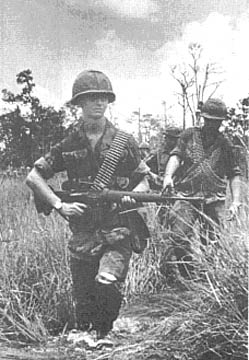 |
TOUGH ON UNIFORMS - This trooper from the 3/4 Cav is tough on uniforms. No wonder. The terrain near the Boi Loi Woods is tough on troopers. (Photo by SP4 Howard Lavick) |
Enemy Is Surprised While on Police Call
By SP4 FRANK H. SALERNO
CU CHI - While on patrol
recently 12 miles north of here, an element of the 25th Division’s 2nd
Battalion (Mech), 22nd Infantry, popped an ambush which killed one enemy as he
policed up soda cans.
“Our ambush site was at
our previous night laager position and, shortly after dark, we heard digging
sounds,” said Charlie Company Private First Class Marvin Witt of Greenwood,
S.C.
“We called in that we had
movement nearby and everyone was tense and alert because the sounds were coming
our way.”
Before long the men saw
three enemy digging up the trash the GIs had buried that morning. As they sorted through it, they kept all the empty pop cans.
“They were probably going
to use them for booby traps,” said Sergeant Rodney Babin of Fort Kent, Maine.
Seconds later the men
engaged the enemy with claymores and small arms fire while receiving no return
fire.
A sweep of the area produced
one dead Communist, one M-26 hand grenade, three shirts, three pairs of Ho Chi
Minh sandals, several sandbags containing US rations and several dug up soda pop
cans.
Page 2 TROPIC LIGHTNING NEWS September 21, 1970
Decorated
| BRONZE STAR | |
| CPT James M. Pogue, Co C, 1st Bn, 5th Inf 1LT Neil Y. Morimoto, HHC, 1st Bn, 5th Inf 1LT Peter K. Ransom, Co A, 4th Bn, 23d Inf 1LT Douglas P. Schultz, Co C, 1st Bn, 5th Inf 1LT Hector Saenz, Co B, 1st Bn, 5th Inf SFC Roger L. Jackson, Co A, 1st Bn, 5th Inf SFC Raymond H. Wood, Co B, 1st Bn, 5th Inf SSG Timothy D. Troyer, Co C, 1st Bn, 5th Inf SGT Homer A. Brown, Co B, 2d Bn, 12th Inf SGT Craig P. Carroll, 25th MP Co SGT Norman D. Shirley, Co C, 1st Bn, 5th Inf SP5 Dean L. Eikman, HHC, 1st Bn, 5th Inf SP4 Jesse A. Bums, HHC, 1st Bn, 5th Inf SP4 Douglas T. Carter, HHC, 1st Bn, 5th Inf SP4 James A. Carter, HHC, 1st Bn, 5th Inf SP4 Robert A. Cogdill, Co C, 1st Bn, 5th Inf SP4 William R. Dobie, Co B, 2d Bn, 12th Inf SP4 Randall Hill, HHC, 1st Bn, 5th Inf |
SP4 Richard R. Jennings, Co B, 2d Bn, 12th Inf SP4 James R. Lempke, Co B, 1st Bn, 5th Inf SP4 Fredrick N. LoBue, Co B, 1st Bn, 5th Inf SP4 Garold D. Norman, Co C, 1st Bn, 5th Inf SP4 Jack R. Schmidt, HHC, 2d Bn, 12th Inf SP4 Sim L. Sharpe, 25th MP Co SP4 Billy E. Teague, Co C, 1st Bn, 5th Inf SP4 Jerry A. Thomas, 25th MP Co SP4 Clifford L. Tyree, Co C, 1st Bn, 5th Inf SP4 Harold L. Watkins, Co B, 3d Bn, 22d Inf SP4 Daniel A. Watwood, Co B, 2d Bn, 12th Inf SP4 Roger R. Wood, Co B, 1st Bn, 5th Inf PFC William I. Ausbrook Jr, Co B, 3d Bn, 22d Inf PFC Anthony F. Chetko, Co C, 1st Bn, 5th Inf PFC James Tournir, Co B, 3d Bn, 22d Inf PFC Thomas Oates, C Trp, 3d Sqdn, 4th Cav PFC Ronald Overson, C Trp, 3d Sqdn, 4th Cav PFC Jeffrey Schinaman, C Trp, 3d Sqdn, 4th Cav |
Carpenter Turned Soldier Is Expert Bunker Builder
BY SP4 ED TOULOUSE
DAU TIENG -- Fortified
bunkers are the “in” thing at this 25th Division base camp, and there’s a
man here who’s making bunker building his military profession.
Specialist 4 Doug Kohls of
Milwaukee, a member of the 2nd Battalion, 12th Infantry, is a skilled carpenter
who has worked on schools, apartment buildings, and even churches. But he had never filled a sandbag -- at least not until he arrived here.
Finished carpentry skills
may not be necessary but the requirements of a bunker are demanding. Fifteen hundred sandbags (total weight 50,000 pounds), many wooden
timbers, and about a week of Kohl’s work will make one of these miniature
fortresses virtually impregnable.
The task, as Kohls often
points out, is a difficult one, but an ounce of sweat may mean a sandbag-layer
of protection, so especially important during a mortar attack.
Cu Chi Amnesty Program
Helping Addicts Go Straight
By 1LT ROBERT GOLDEN
CU CHI - The Drug Amnesty
Program is designed to help drug addicts and pot-smokers kick the habit without
being prosecuted, harassed and without compiling any sort of “record.”
The Tropic Lightning’s
25th Medical Battalion established the no-risk mental hygiene consultation
service a year and a half ago. Specialist
5 Robert Pirozzoli of Bridgeport, Conn., has been working with the volunteer
patients since last November.
“If a man is on drugs or
marijuana and wants to go straight, he should go to his commanding officer or
first sergeant. There won’t be
any article 15s, courts-martial or any other sort of disciplinary action taken.
We treat this as a purely
medical problem and no permanent records of the case are kept. When a man leaves the division, his records are destroyed.”
Pirozzli, one of six
technicians who work with the drug patients, said most of the people he’s seen
are psychologically hung up on grass. The
clinic’s full-time psychiatrist, Dr. (Captain) Phillip W. Cushman, noted that
there is never any physical addiction with marijuana.
“It’s just a psychological thing and if they decide they want to give it up, there’s no
problem - most of them need a little nudge to help them decide to quit
smoking.”
The program has been highly
successful, according to Pirozzoli. “When
we get the patients, they’ve already decided they want to quit. Our job is to give them medication, when necessary, to fight withdrawal
and then to counsel them,” Pirozzoli explained.
Cushman and Pirozzoli both
agreed that imminent DEROS dates are the most frequent cause for men coming to
them with the drug problem. But
Pirozzoli noted that a lot of men come in after having seen a buddy going
through withdrawal. “Sometimes
that sort of thing really scares them and jolts them to their senses,” the
specialist added.
Cushman emphasized the “no
repercussions” guarantee of the program. Besides stressing the no disciplinary action and no records kept aspect,
the doctor pointed out that this program provides for the only “priviledged
communication with a psychiatrist” in the Army.
“I’d like to see some
more patients in here,” Pirozzoli said. “I
don’t think the word is getting out about this program. We had five patients last month and I’m sure we would have
had more if the word about us was spread around more.
The guys can go through
their CO, first sergeant, chaplain, Red Cross or come right into our office -
we’re here to help.”
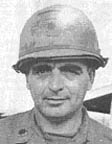 CHANGE OF COMMAND
CHANGE OF COMMAND
Lieutenant Colonel Ralph Salucci, former executive officer of the 1st Brigade,
has assumed command of the 2nd Battalion, 14th Infantry Golden Dragons. Salucci succeeds Lieutenant Colonel Charles W. Norton Jr.
Tropic Lightning Tots
The Commanding General Welcomes
The Following Tropic Lightning Tots
To The 25th Infantry Division – As
Reported By The American Red Cross.
Born To:
| August 27 PFC Richard Nutt, C Co 4th Bn 9th Inf, boy SP4 Ronnie 0. Wagstaff, C Co 3/4 Cav, boy August 28 SGT Monte L. Burgess, A Co 125th Sig, boy SGT Carroll B. Froah, B Btry 1st Bn 27th Inf, boy August 29 PFC Ernest Roche, A Co, 1st Bn 27th Inf. boy SP4 Freddie E. Weise, 362 Eng Bn, girl SP4 Ronald Neal, HHT 3/4 Cav, boy |
August 30 SP4 Thomas D. Yeager, Nui Ba Den, girl August 31 SP4 Robert E. Sanslow, E Co 725th Maint Bn, girl SP4 Joe G. Mata, B Co 588th Engr, girl September 1 SP4 Jackie D. Brown, B Co 1st Bn 27th Inf, boy PVT Robert M. Harris, HHC 588th Engr. girl PFC Richard Sharpin, 25th Admin Co, girl |
The TROPIC LIGHTNING NEWS is an authorized publication of the 25th Infantry Division. It is published weekly for all division units in the Republic of Vietnam by the Information Office, 25th Infantry Division, APO San Francisco 96225. American Forces Press Service and Army News Feature materials are used. Views and opinions expressed are not necessarily those of the Department of the Army. Printed in Tokyo, Japan, by Pacific Stars and Stripes.
MG Edward Bautz, Jr . . . . Commanding General
MAJ Robert E. Kelso . . . . Information Officer
1LT Martin E. Webb . . . . Officer-in-Charge
SP4 William M. Lane . . . . Editor
SP4 Scott Watson . . . . . . Assistant Editor
SP4 Joseph V. Kocian . . . Production Supervisor
BATTALION CORRESPONDENTS
| SGT Mike Keyster SP4 Tom Benn SP4 Frank Salerno PFC Dan Lowry SP4 Greg Duncan SP4 Rich Erickson SP4 Ed Toulouse SGT Mark Rockney SGT Mike Conroy SGT William Zarrett SGT Daniel House PFC Irwin Polis SP5 Tom Watson |
4/23 7/11 2/22 2/27 2/27 2/14 2/12 2/12 3/4 Cav 4/9 4/9 269th 725th |
SP4 William McGown PFC James Stoup SGT Derr Steadman SP5 Doug Sainsbury SP4 James Duran SGT Jack Strickland SP4 Kris Peterson SP4 Frank Morris SGT Bob Lodi SGT Dan Davis SGT Jack Strickland SGT Byron Fites PFC Doc Polis |
Divarty 65th Eng Discom 2/77 3/13 1/27 3/22 2/34 1/5 1/27 1/27 4/23 269th |
Page 3 TROPIC LIGHTNING NEWS September 21, 1970
Sweet Sue Gelling Her Revenge
Grand Old Lady Finally Going Home
By SP4 DENNIS EEBLANC
CU CHI - “Sweet Sue” got
her revenge, and now she’s going home.
After 10,000 miles and 17
months of full combat duty, a 25th Division armored personnel carrier known as
“Susie” or “Sweet Revenge” recently ended her tour in the Republic of
Vietnam.
The Bravo Company 2nd
Battalion (Mech), 22nd Infantry Regulars met “Susie” in early March of 1969
when she joined second platoon. The
APC compiled an excellent record for reliability, as the company log books and
her crew would attest.
“She was always in the
lineup whenever the company moved,” said Specialist 4 Royal Mattson of Minneapolis. “She
spent very little of her time in for repairs.”
As the months passed, it was
obvious to the Triple Deuce company that Susie was going to be a record setter.
Before going home the vengeful carrier would see action throughout the
division’s area of operations, including Cambodia.
She traveled in excess of
10,000 miles - a record for Bravo Company. Also, the 17 months in the field broke the old company record for
consecutive field time.
“There was a challenge and
responsibility in driving the oldest track in the company, because we wanted her
to keep that reputation.” said Specialist 4 Bob Stevens of Ottawa, Kansas.
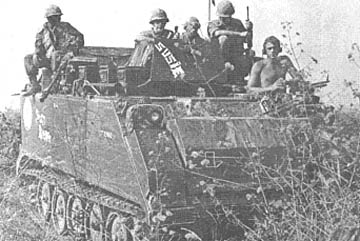 |
TAKING FIVE BEFORE TAKING OFF -- Before ending her tour of duty recently, Sweet Sue and her crew from Bravo Company, 2nd of the 22nd, pause and pose. (Photo by SP4 Dennis LeBlanc) |
It’s Happening
LOST AND FOUND . . . The Warriors of the 2nd of the 12th have misplaced their
totem pole. Which is no easy task. The pole measures 40 feet from end to end and has a large combat
infantryman’s badge as one of its distinguishing features. The Warriors took great pains in shipping the thing from Ft. Lewis to Dau
Tieng a few years ago. They took it
apart in the world, shipped it in segments, then put it back together again over
here. But when the 2nd of the 12th
was hastily redeployed around Saigon in 1968, nobody thought to bring along the
pole. So if you happen to stumble
upon a piece of lumber featuring carved figures of men fighting in the War of
1812, Mexican War, Civil War, World War I, World War II and Vietnam, dial Dau
Tieng and tell a Warrior about it.
OLYMPIC VILLAGE TO OPEN . . . First Lieutenant Ernie Gilkerson, assistant
special services officer, stopped by this week to give us the word on the
special services sports program. His
major piece of news was that Cu Chi’s Olympic Village will open soon. The village, located adjacent to the Lightning Bolt entertainment area
behind the service club, will include a boxing ring, four softball fields,
basketball courts, horseshoe pits and perhaps a football field. The ring will open on Friday, September 25th at 7:30 p.m. with a card of
six bouts. Thereafter, regular
Friday night fights will be scheduled. Gilkerson
said that special services is eager to form a post softball league. Any units wishing to field a team should call PFC Larry Hand at extension
5044. Also, a physical fitness club
for joggers is in the works.
DON’T LET THEM DO IT TO US AGAIN . . . The Bunker Bunnies, a softball team
composed of the girls from 12th Evac and special services, recently struck down
a team from Little Bear operations 11 to 6. The men, it must be admitted, were playing under some handicaps.
First, the pitches were slow teasers by rule. None of the fast stuff was allowed.
Second, the men were bound to bat left handed if they were right-handers
and right handed if they were natural southpaws. The Bunnies, flushed with success, are willing to take on all comers.
Men, we can’t let them do it to us again. Somebody put together a team of switch hitters (there can’t
be any rule against that) and blast them. Please.
WHAT A DIFFERENCE A MONTH MAKES . . . In the August 17 issue of the “Tropic
Lightning News,” we ran a picture of the brand new sign erected at Fire
Support Base Redleg. There wasn’t
a scar on it. Times have changed. And one of our office’s ace photographers Jay Hall caught the change on
film. The Redleg sign is now
covered with shrapnel wounds dutifully patched up with band-aids. Never let it be said that the men of the 2nd of the 77th don’t go on
MEDCAPs.
New Standdown Program
Artillerymen Get A Breather
By SP5 DOUG SAINSBURY
CU CHI - Pity the poor 25th
Division artilleryman. He never
gets a standdown. Well, he never
used to.
“A direct support
artillery battalion cannot stand down a firing battery, even for one day,”
said Lieutenant Colonel Thomas L. Kelly, 2nd Battalion, 77th Artillery
commander.
“Traditionally, tactical requirements for artillery units
have been such that the batteries must stand ready to fire support for the
infantry at all times,” Kelly of El Paso, Tex., explained.
The requirements placed upon
infantry units allow for periodic rest periods for the grunts. When one element comes in for standdown, another element
moves to the field to replace it.
 However, the Up Tight
artillery recently initiated a program to bring a permissible number of men from
a support base firing battery into Cu Chi periodically. Besides working on their howitzers and truck, they can relax
under the comfortable base camp conditions for a few restful days.
However, the Up Tight
artillery recently initiated a program to bring a permissible number of men from
a support base firing battery into Cu Chi periodically. Besides working on their howitzers and truck, they can relax
under the comfortable base camp conditions for a few restful days.
Under the program, twelve
men from a firing battery come into Cu Chi in the late afternoon of the first
day of the rest period. They
in-process, draw clean linen and enjoy a cookout in the evening.
Private quarters for these
Redlegs were made available by renovating an existing building in the battalion
headquarters area.
During the morning of the
second day, the cannoneers move their truck and howitzer to D Company, 725th
Maintenance Battalion here where both pieces of equipment undergo a thorough
technical inspection.
While the truck and howitzer
receive their going-over, the crew returns to the arty battalion area to phase
out unserviceable field gear and individual clothing.
The afternoon of the second
day finds the Redlegs in the battalion motor pool correcting deficiencies noted
during the morning’s inspection.
On the morning of the third
day, the cannoneers run a basic periodic test on their “one-oh-deuce.”
This test is to insure that the sensitive instruments on the howitzer are
operating properly to provide critical accuracy when firing.
In the afternoon the men
have transportation available for visiting base camp facilities. The evening is full of free time as well.
The program allows about 72
men per firing battery to rotate into Cu Chi every three months.
“The implementation of the
program serves two primary objectives,” Kelly said. “The first is thorough testing and maintenance to insure that the
howitzers and equipment are constantly in top shape.
“The second is just to
allow the men a chance to enjoy the facilities available here.”
Quick Thinking Pilot Wins Broken Wings
By PFC IRWIN POLLS
CU CHI -- The Broken Wing
Aviation Safety Award was recently presented to a quick-thinking helicopter
pilot working with the 25th Division.
Second Lieutenant Gerald L.
Anderson of the 242nd Assault Support Helicopter Company received the award for
successfully recovering his CH-47 Chinook helicopter from an in-flight engine
failure. Brigadier General Jack W.
Hemingway, 1st Aviation Division commander, made the presentation.
The award is given to an
Army aviator who demonstrates the highest degree of professional aviation skill
and judgment while recovering an aircraft from an in-flight failure or
malfunction necessitating an emergency landing.
During the early morning
hours of April 19, 1970, Anderson of Sioux City, Iowa, was carrying supplies
into Fire Support Base Mace located at the base of Gia Ray mountain. On board were 12 passengers.
He had picked up 4,000
pounds of ammunition from three trucks and was hovering 75 feet above them when
his caution light for the number two engine went on. As Anderson started to move the Chinook back to the ground to
check out the engine, it failed.
The aircraft began to fall
with its load. Anderson vainly
attempted to increase his RPM’s to avoid hitting the trucks, but the
helicopter came down, the load landing on the trucks.
Once the cargo was down, the
aircraft moved up again. But as it
did the cargo hook became entangled in the webbing, the strap tightened and down
the Chinook went again.
Within seconds, the
quick-thinking Anderson skillfully got rid of his load and brought the aircraft
down next to the trucks. He also
had avoided landing in the two gulleys boardering the area.
Luckily, there was no damage
to the Chinook, and no injuries to crew members or passengers.
Anderson is the first Army
aviator to receive the Broken Wing Aviation Safety Award for a multi-engine
aircraft.
Page 4-5 TROPIC LIGHTNING NEWS September 21, 1970
The Night Ambush
Story and Photos By SGT MIKE KEYSTER
FSB LYNCH - Despite the
weather or personal feelings, ambush is a nightly activity for the men of the
4th Battalion (Mech), 23rd Infantry.
A Tomahawk grunt pulls an
average of one ambush every three nights and each company is responsible for one
every night.
Night Charlie hunting is an
altogether different task from the daylight patrol. Night activities demand the use of more equipment, because
“a unit has to have a lot of firepower when it goes out on its own,” said
Sergeant Gary Eagleton, a squad leader from Woodland, Calif. Eagleton has had over nine months of bushing experience.
Claymores, trip flares,
extra ammo and grenades are just some of the added equipment carried on each
nocturnal mission.
The job means walking in the
dark, finding a place to set up, fighting off the swarming mosquitoes and
humping the extra equipment. But,
most of all, it means extra alertness.
Bravo Company grunts say the
monsoon rains are their worst enemy.
“I hate the rain most of
all,” said Private First Class Marvin Rhodes of Bowie, Tex. “If it rains, you stay wet all night, and then you
freeze.”
“During the rainy season,
nobody has a good night,” added Private First Class Bob Johnson of Gainsville,
Fla. “Sleeping in the rain is a
real bummer.”
The best thing about a bush,
Tomahawks say, is having a little time off after each mission. About 95 per cent of the time they will get the next day to rest and
recuperate.
Sergeant Bob Lawson, a squad
leader from Dallas, summed up his feelings about nighttime ambushes. “It’s no fun going out there.
You
never really get used to it.”
“We know that gunships,
artillery and mortars are just a few minutes away,” Eagleton added. “But that doesn’t stop you from feeling lonely.”

|
LEAVING THE WIRE - Infantrymen of the 25th Division’s 4th Battalion (Mech), 23rd Infantry pass through the wire on their way to a night ambush position 20 miles south of Xuan Loc. |
| GETTING THE WORD – Tomahawks of the 4th of the 23rd receive briefing. | 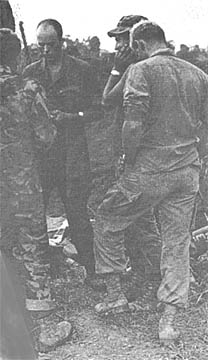
|

|
FINAL CHECK - This infantryman of the 4th of the 23rd makes final commo check before ambush patrol moves out of Fire Support Base Tomahawk. |
Page 6 TROPIC LIGHTNING NEWS September 21, 1970
Bobcats Use New/Old Early Warning System
By SGT BOB LODI
XUAN LOC - Has the 1st
Battalion (Mech), 5th Infantry gone to the birds?
The exploits of Alfa
Company’s chickens have become famous within the battalion, but now Charlie
Company, not to be outfeathered, has added four geese to its roster.
Unusual Request
It all started when
Specialist 4 Richard Minton, Charlie Company resupply man, received an unusual
request.
“I thought my ears had
deceived me,” he said, “but I swore the radio telephone operator said
‘geese. When they asked me to get
six geese harnesses, and fifty pounds of grain, I knew they meant business.”
Charlie Company Commander
Captain James Pogue clarified the situation. He told Minton he wanted the geese for an early warning system.
So, after some sharp haggling with a local villager, Minton procured four geese.
Pogue, an animal lover from
way back, has been aware of the goose’s anti-intrusion capability for some
time.
“Geese have no natural
defense against predators, so they are naturally alert to unusual noises,” he
explained.
According to First
Lieutenant Douglas Schultz, a platoon leader with Charlie Company, the Roman
Legions used birds as sentries. So
does the Jack Daniels distillery and warehouse in Tennessee.
Six and Six
Pogue’s eventual plan is
to have a total of 12 geese, six to the front and six to the rear of Charlie
Company’s night laager sites.
Each of the platoons has
adopted a goose and all havoc breaks loose when they try to police up Bertha,
Rufus, Gus and Norman. About the
only trouble the Bobcats have had with the geese is that they are a little
messy.
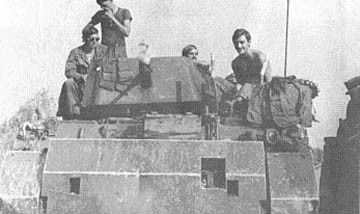
|
RUFUS MANS (GOOSES?) THE GUN - Rufus the goose, the early warning device for Charlie Company, 1st of the 5th’s 2nd Platoon, perches atop his favorite sentry post - a .50 caliber machinegun. (Photo by SGT Bob Lodi) |
725th Has Refrigeration Man
He Keeps Cu Chi Cool
By SP5 TOM WATSON
The 25th Division’s 725th
Maintenance Battalion is “blessed to have in its midst” a person who is
capable of repairing and rebuilding the many various tactical air conditioners
and refrigeration units the Army uses, according to Captain James R. Ritchie of
Cumberland, Md., the shop officer of Headquarters and Company A.
“Refrigeration repair is
much more technical, and more intricately demanding than most repair work and
one must go to school to receive a basic understanding of refrigeration,”
Ritchie added.
Until he came in the Army,
Specialist 5 George A. Windham of Sanford, N.C., worked as a refrigeration
repairman with his father in their family business. “I began working with my father in the tenth grade,” said Windham.
Before coming to Cu Chi and
the 725th, Windham worked for the Ben Hoa-Long Binh post exchange installing and
servicing air conditioners, including the one at the main PX at Cu Chi.
“Windham has the ability
of repairing any type of refrigeration equipment but is hampered in his
operation because of the critical lack of repair parts,” said Chief Warrant
Officer (CW3) Walter J. Gregory of Colorado Springs, Colo., the chief
maintenance warrant officer of HQ & Co A, who believes Windham is “the
best refrigeration man in Vietnam.”
“Probably one of the best
refrigeration men in the Army” corrected Captain William R. Hardgrave of
Witchia, Kansas, the maintenance platoon leader of HQ & Co A.
Windham says his best source
of repair parts is the post’s salvage units. He can modify them by redesigning
their shape or wiring so the system he is repairing will function as a unit.
“If it weren’t for Mr.
Gregory getting me copper tubing and freon (the coolant used in refrigeration
equipment) I wouldn’t be able to do a thing,” said Windham.
“Repairing any
refrigeration equipment is a difficult job,” Windham pointed out. All the parts must be wired in series and function as one
piece. If all the parts don’t
function at the same time, the compressor (the heart of any refrigeration unit)
will overheat and turn the machine off. Refrigeration
equipment just won’t run unless it’s in perfect working order; it’s not
like a car which can run on seven cylinders.”
Windham’s work is not
limited to the shop. He is also
head of a mobile service that goes anywhere to perform maintenance at the site of the problem. From 20 to 30 times a
month, Windham and two of the three men he has working for
him make service calls, whether it be at G-1 or a fire support base.
Ask SGT Certain
DEAR SARGE: I’m a big radio fan. Here
in Vietnam, I listen to AFVN (big choice). Now, the station isn’t all that bad.
For instance, it’s fun at suppertime to watch the city-slickers wretch
over the country and western music, and, I imagine it saves on rations. What bugs me is listening to the same commercials over and over again.
Comrade Nguyen has had five minutes to re-up for the last five years; and
my only suggestion on their “suggestion system” commercial is to take it off
the air. How can we be spared?
Tun Din
DEAR TUN: You are in luck. This
season, AFVN is adding four new commercials to the four they already have.
This means that the same one will be repeated each hour instead of each
half hour. The four new commercials
will include (1) a short talk by Ralph Ginsburg to convince people who’ve
tried marijuana to rehabilitate themselves, (2) a colorful jingle with twelve
sexy girls telling you not to jump headfirst into a scro ditch, (3) a poigniant
drama discouraging you from throwing live frags at your first shirt and (4)
Jimmy Hendrix singing about a Siberia R &R.
DEAR SERGEANT CERTAIN: Maybe I’m a prude, but it makes me very upset to watch
dogs running loose in troop areas around Vietnam. Really, soldiers shouldn’t be allowed to keep canines and
if they are allowed, someone should insist that they put pants on the females.
The carrying on is something terrible.
Putzum Pantson
DEAR PUTZ: Army regulations allow one dog for every twenty GIs but make no
stipulation as to proper uniform. The
dogs don’t offend me; in fact at lunch time, some of us NCOs get together and
watch them. We’ve learned a great
deal from the experience.
DEAR SERGEANT CERTAIN: I’ve always been a lucky gambler. Since arriving in Nam, I’ve invested my paychecks in slot machine
slugs. In the last two months,
I’ve hit 4,873 jackpots. I intend
to use my winnings of $27,826.80 to buy an OD Cadillac on the sides of which I
will letter “The Army Takes Care of Its Own.” I have a little problem though.
Whenever
I bring my foot lockers full of slugs to the Vietnamese clerk at the EM Club to
cash them in, he shakes his head and says “Xin Loi.” I want my money.
What can I
do?
Master of luck
DEAR MASTER: Send the slugs to the Ace Novelty Company in Philadelphia. Ace supplies slugs to the whole U.S. Army open mess system.
Your collection is worth $.75. Maybe
you can use the money to buy an OD rollerskate you lucky son of a gun.
DEAR SERGEANT CERTAIN: Is the division planning any celebration for its 29th
anniversary in October?
Lyle Firecracker
DEAR LYLE: Yes, indeed. All the
tracks operated in the division will be covered with colored bunting and
decorated with scantilly clad girls from the Lightning Center Steam Bath. The tracks will roll up Highway One to a scenic spot and commence fire.
Page 7 TROPIC LIGHTNING NEWS September 21, 1970
Cu Chi Canines Harassed
Scout Dogs Drill to Remain Alert
By PFC DAVE COOPER
CU CHI - Just as the combat
soldier must keep training to remain sharp, the scout dog must drill to stay
alert.
While he is here in the 25th
Division base camp, Prince, a shiny, black German Shepherd with the 44th
Infantry Scout Dog Platoon, continues to train on the lanes.
“The dog must be worked so
he will maintain his acute senses and remain in good physical condition,” said
First Lieutenant Russell E. Murphy Jr. of St. Louis, the platoon leader.
Specialist 4 Russell
Kessler, Prince’s handler, said that on the lanes he will harass the dog by
talking to him suspiciously about the trip wires and the human decoys.
“Scout dogs are more alert
in the field than they are on the training lanes,” said Kessler of
Indianapolis. “They become more
protective because they are around strange people. They seem to sense the danger.”
Dogs are in the field for
about five days at a time and are used primarily on ambush patrols and
reconnaissance missions.
But whether on the lanes or
in he field, scout dogs usually alert between 100 and 150 meters away, depending
on the direction of the wind. The
wind is important because the dogs use “airborne scent” - picking up the
scent a few inches off the ground.
An important factor is the
ability of the dog and the handler to work together as a team.
“All dogs alert, but the
handler must be able to detect it, for the dogs alert in a different manner to
different situations,” Kessler added. “It’s
just a matter of the handler and the dog being able to understand each other.”
The team must be compatible
in order to work. “You can’t have an aggressive dog and a shy handler and
vice versa,” Kessler said.
The handler has five
commands he can give the dog: sit, stay, heel, down and come. A reward and punishment system is used in training.
Scout dogs are effective
from three to six years depending on the dog’s health.

|
HAMMING IT UP -
(Left) Prince hams it up for his handler,
Specialist 4 Russell Kessler, during a lesson in basic obedience. ATTACK - (Right) One hundred and twenty-five pounds of fury named Prince snarls at Sergeant Willie Posey, a human decoy. The dog is being held by Handler Kessler. |
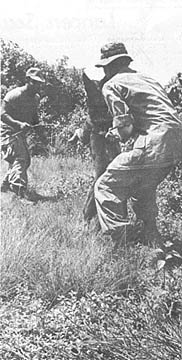
|
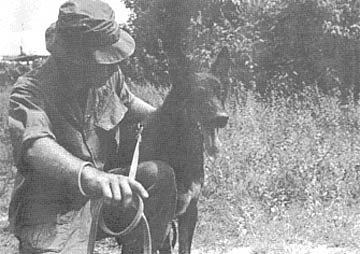
|
WELL DONE - Specialist 4 Russell Kessler gives Prince, a German Shepherd assigned to the 44th Scout Dog Platoon, a little encouragement after the dog successfully completed the training lanes. |
Page 8 TROPIC LIGHTNING NEWS September 21, 1970
Turn Over River Equipment
65th Engineers Launch ARVN Boatmen
By PFC JAMES D. STOUP
BIEN HOA - Three members of
the 25th Division’s 65th Engineer Battalion arrived here recently to turn over
river control equipment to an ARVN unit stationed nearby.
The event was part of the
Army’s ever-expanding role in the Vietnamization program.
Sergeant Charles T. Woods of
Omaha, Neb., served as technical advisor for the group, while Specialist 5
Lavern S. Cameron of Swartz Creek, Mich., and Specialist 4 Frank W. Busher of
Newport, Ky., provided technical assistance. All are with Echo Company of the engineers.
Giveaway
The battalion gave the ARVN
four river boats and five outboard motors for use in patrolling the Dong Mai
River.
Before the turn-over was
completed however, the men spent three days instructing the ARVN troops.
“This is not the first
time we’ve turned-over river boats to the ARVNs,” said Cameron. “The 65th has been involved in this type of operation for
the past few months.”
“We don’t really have to
teach them how to operate the boats,” Woods said. “But we do have to teach them how to maintain the equipment, observe
water safety and courtesy and prepare the various fuel mixtures.”
Captain Harry Glowaski of
Wyoming, Minn., from MACV Advisory Team 98, coordinated the activites for the
65th. He made the physical arrangements and will eventually oversee the river
patrolling operations for the
ARVNs.
Takeover
“The ARVNS will soon take
over all river patrolling operations from US units in South Vietnam,” Glowaski
said.
The engineers confronted few
problems in the turn-over operation.
“The hardest part for
me,” said Sergeant Woods, “was trying to break down the technical jargon I
learned during my training so that the Vietnamese could understand what I was
teaching them.”
| EASY DOES IT -- Technicians from Echo Company, 65th Engineer Battalion, instruct ARVN soldiers on the procedures of operating motor launch equipment. (Photo by PFC James Stoup) | 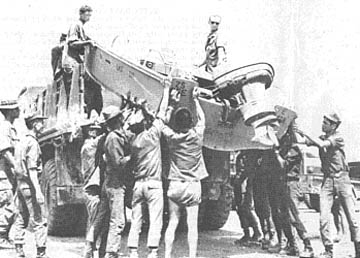
|
1st Brigade Digs In
Lancers Scalp ‘Indians’
By SP4 RICH WERNER
(DAU TIENG) - They call it
“Indian Country,” and Dau Tieng base camp, the new home of the 25th
Division’s 1st Brigade, is located virtually in the middle of it.
Snuggled near the eastern
perimeter is a French-owned rubber plantation, a longtime hiding place of
Communist forces. To the north are
the foreboding Razor Back Mountains, a stronghold from which the enemy has often
lobbed rockets and mortars into the camp below.
South of here are the menacing Hobo and Boi Loi Woods, two more
favorite hiding places of Charlie.
Understandably, then, base
camp defense is of primary concern to the 1st Brigade Lancers. There are numerous bunker complexes along the
berm, supported by a base
camp reactionary force on five minute alert. In addition, there are reactionary forces assigned to each of the four
sectors, permanent and mobile radar and a 100-foot high observation tower
equipped with aiming devices.
All of these are coordinated
at the base camp defense (BCD) operation center with an elaborate communications
system to the bunkers and the artillery batteries.
The artillery units here,
and at the surrounding fire support bases, use a concept called “Quick
Revenge,” which is a defense against rocket and mortar attacks.
Major A. Daniel Dell’Elce,
installation coordinator and BCD commanding officer, from Boston, explained,
“the artillery pre-positions the guns at target areas known to have previously
originated enemy fire. Therefore,
the instant the base camp receives incoming rounds, the artillery can
immediately respond, then later adjust their fire once an exact location is
found.”
“Speed is of the essence
when returning fire, for Charlie knows the faster we are, the less rounds he can
throw at us before the world blows up around him,” commented 1st Lieutenant
Rodney Gibbons of Tulsa, Okla., a BCD officer.
The 10-story high
observation tower contributes greatly to the effectiveness of Quick Revenge.
When exploding rounds are spotted by the observer, he obtains an azimuth
which is then telephoned down to the batteries, said Private First Class Sid
Cassel of Cheyenne, Wyo., 7th Battalion, 11th Artillery tower observer.
“When the action starts,
you’ve got to get a reading as fast as possible,” he said. “It’s probably the safest place to be during incoming,
but the guys down below are counting on you.”
Charlie has found Dau
Tieng’s defenses tough to crack. But
nevertheless, he keeps hoping that the next time he tries, the GI’s will have
their guard down. For instance,
last July the enemy launched a sapper attack against the base. The attack went for naught as 17 died.
None of the Indians even reached the wire.
Grunts Take To Air, Flyboys Come Down
By SP4 GREG DUNCAN
CU CHI - A grunt in the Air
Force?
When Sergeant Tom Buckman of
2nd Battalion, 27th Infantry, learned he would be spending three days with the
Air Force, he couldn’t believe it.
Switcheroo
“They told me that I,
along with two others from the division, would be going to Bien Hoa, and two Air
Force personnel would be coming to Cu Chi for three days,” said Buckman of
Forest Park, Ill.
It was all part of OPERATION
TEAMWORK, an exchange program the Air Force has, not only with the 25th
Division, but with other allied units as well -- including Australians.
Buckman, who was selected
for the exchange because he was “short” and had been in the field for almost
twelve months, was sent to the 823rd Combat Engineer Squadron, part of the 3rd
Tactical Fighter Wing.
Apart from building
practically the entire Air Force complex at Bien Hoa, the 823rd “Red Horse”
unit has had some part in just about every construction project of the Air Force
in the III Corps area.
Like It Is
“Most of the guys asked a
lot of questions and expressed a desire to go to the field with the Wolfhounds
to see what it’s really like,” the sergeant said.
“We gave the flyboys who
came up here a real treat,” he continued. “They went on one of our airmobile missions and also spent one night on
an ambush patrol.”
Different
An Air Force sergeant
observed that the night ambush patrol was quite different from the
air-conditioned club he is accustomed to spending his evenings in.
“While enjoying myself in
their club a little later, I couldn’t help but feel a little sorry for these
guys, knowing they were out in the middle of nowhere sleeping in the rain.”
| CHOW TIME -- This cook of the 4th of the 23rd makes use of a 548 (half track) to prepare chow for hungry Tomahawks in the field. (Photo by SGT Byron Fites) | 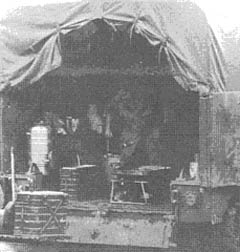
|
The Life of a Cook
By SGT BYRON FITES
FSB TOMAHAWK -- To the
uninformed, the life of a cook in Vietnam must seem great. They stay in the perimeter area all day long and always seem to have ice
for their sodas as well as the best food.
Underneath the glossy
exterior, however, the job of cooking for the 4th Battalion (Mech), 23rd
Infantry isn’t as groovy as the picture might seem.
Cooks get up at least two
hours before most everyone else to prepare the morning meal. Before the stoves are cool and the breakfast pots and pans scrubbed,
Bravo Company Mess NCOIC, Sergeant First Class John Britt of Sandersville, Ga.,
is already thinking about preparing the evening meal.
“I prepare the menus and
the cooks and myself prepare the food,” Britt said. “We cook the evening meal here and send it to the field in insulated
containers which keep it fairly hot for the men.”
Then there are other
problems. When the wind blows from
the northwest, it brings two or three inches of rain along with it or enough
dust to cover the food.
The rain makes the mashed
potatoes soupy while the sand turns them lumpy. “If a tent is available, these problems aren’t so difficult,” Britt
said.
Thanks to
Glenn Kantorski, 4th Bn. (Mech.), 23rd Inf. and 3rd Bn., 22nd Inf., for sharing this issue,
Kirk Ramsey, 2nd Bn., 14th Inf. for creating this page.
This page last modified 11-17-2004
©2004 25th Infantry Division Association. All rights reserved.